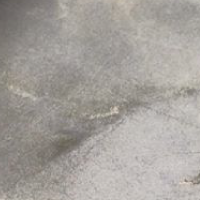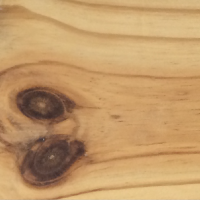迷你樹景護理方法
以下資料是針對初入門的盆景愛好者參考。
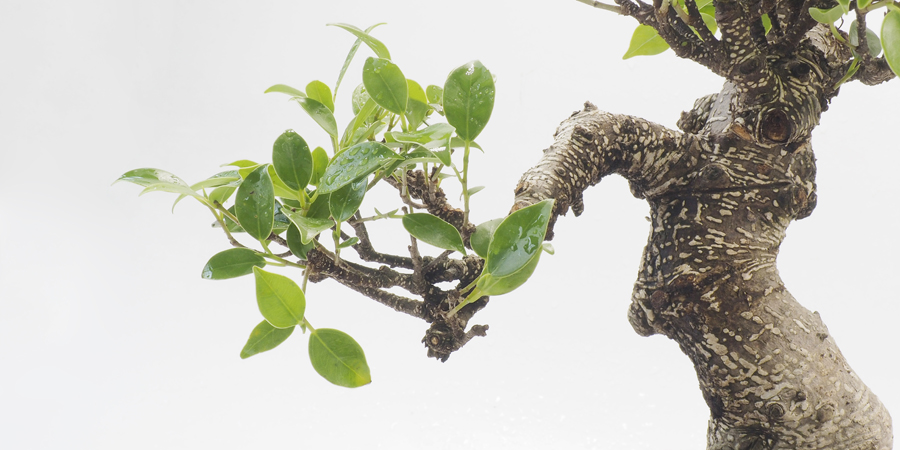 |
盆景/迷你樹景是將大自然中大樹型態縮影於花盆中,取其美、去其劣,對於根盤、幹順、配枝點位、枝棚空間等十分的注重。大部份盆景都是需要長時間的盆培來表現出它的老態,對於花盆的色澤、形狀、尺寸都必須深入的考究。總括而言就是以美學的概念配合人工的方式來表現出大自然的縮影。
盆景的種類大概可區分為4大類:
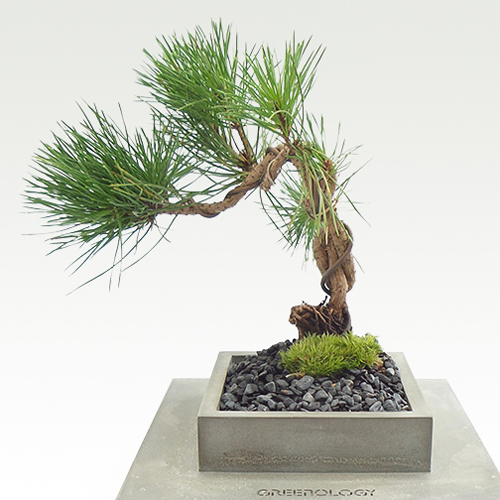 |
松柏盆栽:指常綠針葉樹種的盆栽,如松、柏、杉、檜等等 |
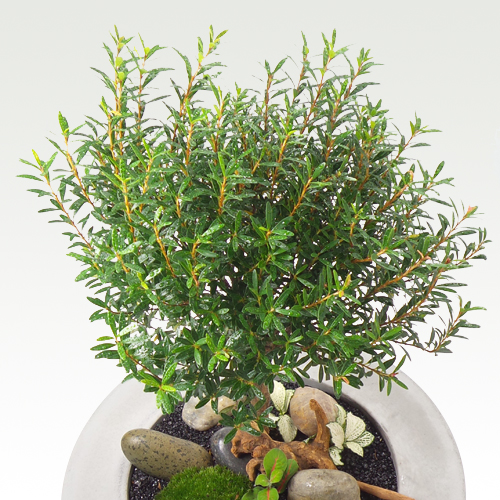 |
雜木盆栽:(常綠系)福建茶、紫檀、黃槴子等等,(落葉系)櫸樹、唐楓、山槭、榆樹等等 |
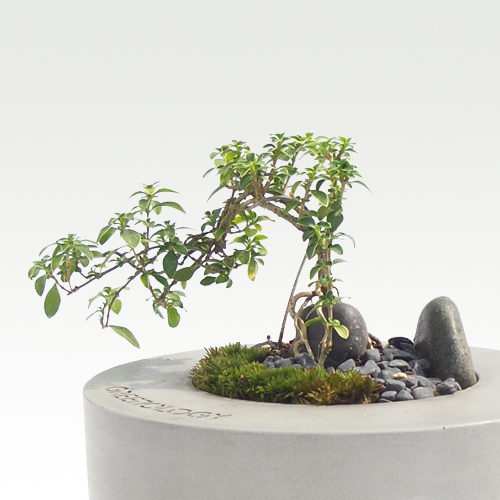 |
花果盆栽:九重葛、皋月杜鵑、紅紫檀、姬柿、鳥梨、茶花、李氏櫻桃等等 |
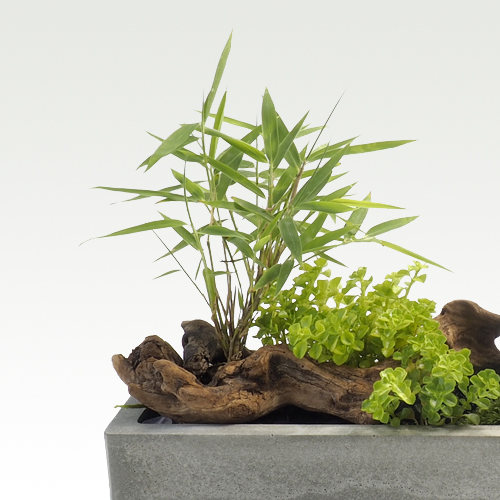 |
山野草盆栽:草本植物為主,可表現出自然山野中花草的縮影等等 |
盆栽護理入門
澆水
盆栽界常言“澆水三年功”意指學澆水就要三年才出師。只要各位緊記以下澆水的基本原則,用心觀察、體會,相信您的盆栽也可以欣欣向榮。
為何要澆水
簡單來說澆水就是為了維持植物的生命,就像人每天要吃飯一樣。盆養的植物澆水不單只是因為澆水使其根部有水份可吸收而已,也會因新注入的水帶着新空氣而排出原本土壤中的舊空氣而促進盆中根部的呼吸作用。
何時要澆水
“一天澆水一次”或“兩天澆水一次”等指引都是植物枯死或根部被水淹死的原因。環境不同、日照、通風條件不同,澆水豈可一視同仁呢!其實何時要澆水是很簡單的 — 只要盆內表面土壤乾燥就要澆水。如果盆土表面未乾就澆水,長期累積下來植物的根部會因土壤太濕而窒息、腐爛。相反,如果盆土已經乾到了盆底卻還未澆水,根部就會因失水而枯萎,當你發現時立即澆水根部卻已經枯萎失去吸收水份的功能,再泡水就會腐爛。因此澆水必須視乎環境不同,日照、通風條件不同去調整澆水的頻率、次數。
水要澆多少
澆水不能只澆表面而已。澆要澆到水份滲透到根部,水已從盆底孔大量排出為止。這樣才能為盆土換氣,促進根部的呼吸作用。
季節、氣候、植物狀況不同時對澆水量的調整
相同種植地方的種植條件會隨著一年四季中季節、氣候、日照的變化而改變。因此建議用心觀察家裏或辦公室的環境條件,隨著環境條件起變化、盆土的乾燥程度和速度亦會起變化,再進而調整正確的澆水時機。
每棵植物狀況不同時,對澆水的時間、量也必須調整。譬如剛修剪過或秋冬已落葉的樹種,因植物根部吸水、葉面蒸發水份的緣故,所以落葉期的澆水量必須另外管理,不可與其它常綠樹種一視同仁,以免盆土太濕導致根部腐爛。否則到了春天長新芽時才發現新芽長得稀疏、有些枝條已枯乾,這就已經為時已晚。
另外如剛換泥、開花中、結果中、闊葉木、針葉木等等的植物狀況不同,澆水的量也必須加以調整。但萬變不離其宗,只要盆內表面土壤乾燥就要澆水,只是視乎每個盆栽植物個體的條件不同而需要加以調整。如果有栽種多款盆栽的話,最好區分出松柏常綠樹種、闊葉常綠樹種、落葉樹種,並分區管理方便澆水。
容易被誤導的澆水時機
下雨天時,尤其是梅雨期間小雨下下停停的狀況下,容易使盆土只達到表面濕而已,真正盆底的根卻吸不到水,尤其樹冠越大、像把雨傘的就要更加小心。
另外,盆土表面因為施肥、裝飾等原因而佈滿青苔完全看不到盆土時,常常會以為青苔看起來綠油油的而忽略底下的泥土已經乾了。
其它澆水時要注意的事項
- 澆水最好用澆水壺,水花越小越好
- 夏天正午打開水龍頭時要先把水管內熱水排走再澆灑盆栽,以免燙熟植物
- 澆水要讓水花像下雨一樣自然落下,不要對著盆土沖洗
盆栽護理入門
施肥
為何要施肥
盆栽植物培植於花盆中其空間、用土有限,自然養份也有限。為了盆栽植物的正常成長,養份的補充是必要的,所以施肥也是盆栽日常管理中非常重要的一環。
一般常說的肥料三要素是指:氮、磷、鉀三種成份。氮素可促進枝葉、根部的生長。磷酸除了有助根部、枝葉的生長外,對於促進花果類盆栽的開花、結果更是重要。至於鉀則是對於幹、根、花和果實及植物的整體生產都很重要。
肥料又可以分為有機肥料及化學肥料。一般盆栽使用有機肥料較安全,不易灼傷植物,但易生異味蠅蟲。化學肥料則因肥效太強,使用不當容易灼傷植物所以較少使用。現在市面已有一些效果不錯的合成肥料,只要依照包裝上的說明使用效果不錯,不容易灼傷植物且不會產生異味蠅蟲。
何時要施肥
一般植物會隨著一年四季氣候的變化而產生一年間的生長週期,所以施肥的時間、施肥的量都必須要配合才能被植物有效利用。概略將植物生長週期的時間、施肥量說明如下:
營養生長期
約4月 - 6月
新芽隆起、萌動生長到新芽停止伸長、枝葉生長充實為止。此時期澆水、施肥為盆栽管理上的重點。但是早春施肥與春芽的生長無關,因春肥需在新葉完全展開後才能被植物利用。萌春芽時所需的能量是靠前一年施秋肥時所蓄積的養份,此養份必須靠水份來誘出利用,所以此時期的澆水管理十分重要。到新葉完全展開、葉面面積擴大時,需要的肥量大增。此時需注意肥料的補給,一個月至少施肥一次。施放量則以 4 - 5月中旬為一般量,5月中旬 - 6月底除了基本施肥外可配合每星期一次的水肥補給。
生殖生長期
約7月 - 8月
有一定樹齡的樹木過了營養生長期,為了繁衍後代就會開始進行花芽分化,所以此時期稱為生殖生長期。植物新梢伸長到停止時,其葉腋、枝頂會再度分化出葉芽,而當這些葉芽轉變稱花芽時就成為花芽分化。花芽分化會因樹種及所在地氣候之不同而時間上會有差異,但大多樹種集中於 7 - 8月間分化花芽。此時期的花果類盆栽宜施放低氮高磷、高鉀之花果肥,促使植物的花芽分化更完全,來年春天可綻放更多花朵、結出更大的果實。至於其它盆栽樹種於此時期則宜施放少量基本肥,每個月更換一次即可。
營養蓄積期
約9月 - 11月中旬
進入 9月後白天氣溫仍高,但入夜後氣溫快速降低,形成很大且明顯的日夜溫差。此時是最適合植物將光合作用所產生的碳水化合物合成蓄積的時期,植物根群發育也是最活躍,也是盆栽施肥管理最重要的時期。此時期植物所蓄積的碳水化合物如果不足將明顯反映在明年春芽時的萌動無力、不均,而雜木類、落葉樹類則有易失小枝等現象。此時必須給植物充分的施肥、充分的日照,並保持健全的葉面作光合作用,才能蓄積充足的碳水化合物過冬。故 9 - 10月底除了多量的盆面置肥外,另可配合每星期一次的水肥補給。11月初 - 11月中旬則開始減少盆面置肥並停止施放水肥。
休眠期
約11月中旬 - 3月
進入休眠期後,部份松、柏等常綠樹種並沒有很明顯的休眠期。少量的施肥仍無礙,但落葉類和雜木類則需要停止施肥,將管理重點放在水份管理上。落葉樹過冬時失水或過濕致死、失枝時常發生。
施肥要注意的事項
- 依肥料包裝上的說明使用,並依花盆大小及樹種類別、需肥量的不同而調整用量、次數
- 盆栽不施肥不見得會死,最多是發育不良,但是施肥過量則是會枯死的
- 剛換土的盆栽一個月內不可施肥,需待其根、葉可正常代謝後才能施肥
- 雜木盆栽修葉前兩週先施肥可促使它有足夠的能量再長出新芽,但是修葉後、新芽未開葉前不可施肥
- 植物得病、衰弱時不可施肥
- 以上施肥的論述因盆栽樹種不同、所在地氣候不同及盆栽植物的成品度不同,施肥量都必須加以調整
Concrete is a mixture of aggregates and the result of chemical reaction between cement powder and water. During this complex curing process, each cement-water compound reacts individually causing nonuniform result that gives each product a unique pattern. In certain situations, air bubbles can be trapped in the mixture, producing tiny holes in the product.
Wood is a living product that changes and ages over time. Checks and small cracks are normal in the aging process and are not considered damage. Wood knots, though being considered a defect for structural purposes, are beautiful accents to our products.
Before leaving our workshop, each concrete and wood component of Greenology products are protected with a layer of clear matte lacquer. Never use abrasive cleaners or household cleaning products on our finished products. In most cases, spills can be wiped up with dry soft clean cloth. Avoid heat and direct sunlight to lacquered surfaces.
我們每一盆售出的盆栽都應附有一塊標籤着英文字母 A - M 的小膠牌。對應下面資料就知道要怎樣照料你的小盆栽。萬一找不到小膠牌、又或看不懂下面資料也不用擔心,請你提供你的電郵地址,我們會與你聯絡。
A 一般植物 + 淺盆(無孔)花器 Regular plant + Shallow planter w/o drainage hole
避開表面裝飾晶石,用手觸摸泥土,乾涸、鬆散時才澆水。植物幹部需要適當乾涸時間才能健康生長。澆水時要慢些,使泥土可吸收足量水份至有水溢出為止。之後把多出水份倒去便可。
Push aside pebbles or gravels, use your hand to touch and feel the soil. Soil sticks together when wet, water only when the soil is dry and become loose.
When you water the plant, do it very slowly until there's a layer of excess water forming above the soil. Gently pour away the excess water.
B 一般植物 + 淺盆(有孔)花器 Regular plant + Shallow planter w/ drainage h
避開表面裝飾晶石,用手觸摸泥土,乾涸、鬆散時才澆水。植物幹部需要適當乾涸時間才能健康生長。澆水時要慢些,使泥土可吸收足量水份至有多餘水份從底孔流出為止。
Push aside pebbles or gravels, use your hand to touch and feel the soil. Soil sticks together when wet, water only when the soil is dry and become loose.
When you water the plant, do it very slowly until there's a steady stream of water draining down the drainage hole.
C 一般植物 + 深盆(無孔)花器 Regular plant + Deep planter w/o drainage hole
初購回時,請每天檢視一次,直至能掌握盆栽受水時間及特性。
每次檢視時,都應以竹籤/牙籤插入泥土,靜待5秒後抽出並查看竹籤及附在竹籤上的泥土濕度。若乾涸、沒有濕泥黏着就要澆水。澆水必須慢慢以繞圈方式澆,待泥土有充足時間吸收。第一、二圈會發現吸收力非常快速,直至吸收力減慢就可停止。若不為意澆多了就傾側花器讓多出水份流走。
Please test the moisture level of the soil daily in the first few weeks to understand its needs.
Insert a toothpick into the soil, pull it out after 5 seconds and feel the wetness and/or soil attached to the toothpick. Water the plant only if the toothpick is dry without any moist. Watering has to be done very slowly in circles. Water will go down very fast in the first few rounds. Stop watering when the soil can hardly absorb any more water. In case you have over watered and there's a layer of excess water formed, gently tilt the planter and pour away the excess water.
D 一般植物 + 深盆(有孔)花器 Regular plant + Deep planter w/ drainage h
初購回時,請每天檢視一次,直至能掌握盆栽受水時間及特性。
每次檢視時,都應以竹籤/牙籤插入泥土,靜待5秒後抽出並查看竹籤及附在竹籤上的泥土濕度。若乾涸、沒有濕泥黏着就要澆水。澆水必須慢慢以繞圈方式澆,待泥土有充足時間吸收。第一、二圈會發現吸收力非常快速,直至吸收力減慢並且有多餘水份從底孔流出為止。
Please test the moisture level of the soil daily in the first few weeks to understand its needs.
Insert a toothpick into the soil, pull it out after 5 seconds and feel the wetness and/or soil attached to the toothpick. Water the plant only if the toothpick is dry without any moist. Watering has to be done very slowly in circles. Water will go down very fast in the first few rounds. Stop watering until there's a steady stream of water draining down the drainage hole.
E 需長期泥土濕潤植物 + 透明玻璃花器 Plants that favor damp soil + Transparent planter
目測,泥土乾涸變淺色時就需要澆水。澆水要均勻地讓泥土變深色而表面不積水。如有積水則需要把多餘水份倒走。
Water when the color of the soil lightens. When you water the plant, do it very slowly and evenly until soil color darkens completely. Pour away excess water if there is any.
F 需長期泥土濕潤植物 + 非透明花器 Plants that favor damp soil + Non-Transparent planter
泥土需保持濕潤,有陽光照射或乾燥天氣時需每天澆水。如泥土表面有積水則需把多餘水份倒走。
Soil has to be kept moist at all times. Water daily if there's direct sunlight or when air humidity is low. Pour away excess water if there is any.
G 水栽植物 + 玻璃花器 Hydroponic plant + Transparent planter
花器底部有不同石材作儲水層,澆水時不要超過儲水層以保持根、幹部不會因長期浸水而壞死。植物會隨著本身需要而自行吸取儲水層之水份。
目測,儲水層石仔呈乾涸沒水時就需要澆水。
Pebbles are used to form a reservoir layer in the planter. When you water, keep the water level within the reservoir layer to avoid rotting the root and stem. Plants' root will grow and extend to reach water as needed. Water when you see water level in the reservoir layer is low.
H 水栽植物 + 非透明花器 Hydroponic plant + Non-Transparent planter
需要長期有存水。
Fresh water is needed at all times.
I 青苔 Moss
每天需表面噴水,直至顏色保持深綠。每三至四天加水進青苔底部以長期保持水份。
Mist the moss with water every day to keep it dark green in color. Add water to the moss every 3-4 days to keep it moist.
J 多肉植物 + 有孔花器 Succulent + Planter w/ drainage hole
以竹籤測試泥土,在泥已經乾透,同時看見植物出現軟弱或下垂或皺紋時(約10至30天,視不同氣候環境而定)就需要澆水。澆水要澆至有多餘水份從底孔流出為止。
Water only when the succulent leaves turn weak or droop or seeing wrinkles (approx. 10-30 days, depending on the environment). When you water the plant, do it very slowly until there's a steady stream of water draining down the drainage hole.
K 多肉植物 + 無孔花器 Succulent + Planter w/o drainage hole
以竹籤測試泥土,在泥已經乾透,同時看見植物出現軟弱或下垂或皺紋時(約10至30天,視不同氣候環境而定)就需要澆水。澆要澆足,並必須把多出之水份倒走。
Water only when the succulent leaves turn weak or droop or seeing wrinkles (approx. 10-30 days, depending on the environment). When you water the plant, do it very slowly until there's a layer of excess water forming above the soil. Gently pour away the excess water.
L 草球 Kokedama
以手觸摸水苔球表面乾涸時,把整個球放入水盆中浸約1分鐘。待吸滿水份後取出並瀝乾水份便可。
When the surface of the kokedama feels completely dry and crunchy to the touch, soak the entire kokedama in a water bowl for at least 1 minute. Wait until the peat moss absorbs water fully and changes color, remove it from water and drip dry it.
M 迷你樹景 Bonsai Trees
迷你樹景是把大樹縮影於花盆內。由於空間有限、用土有限,無論水份及養份都需較植地為多。
詳情請參閱Greenology網上指引 How to take care of Bonsai 。
Bonsai is an art of potting a tree in a small planter. Due to lack of space and soil and underground water, watering and fertilizing are both frequently needed to keep the bonsai in shape. Refer to detailed instructions on Greenology website.
N 盆底吸水 Sub-Irrigation
初購回時,請每天檢視一次,直至能掌握盆栽受水時間及特性。
以竹籤/牙籤插入泥土,靜待5秒後抽出並查看竹籤及附在竹籤上的泥土濕度。若乾涸、沒有濕泥黏着就要澆水。澆水方法把器皿浸在水盆,水位為器皿高度的1/3左右,讓泥土自然吸收水份至濕透。
Please test the moisture level of the soil daily in the first few weeks to understand its needs. Insert a toothpick into the soil, pull it out after 5 seconds and feel the wetness and/or soil attached to the toothpick. Water the plant only if the toothpick is dry without any moist. When you water, place the entire planter in a water bowl with water level at 1/3 of the planter. Let the soil absorb water from underneath as needed.






